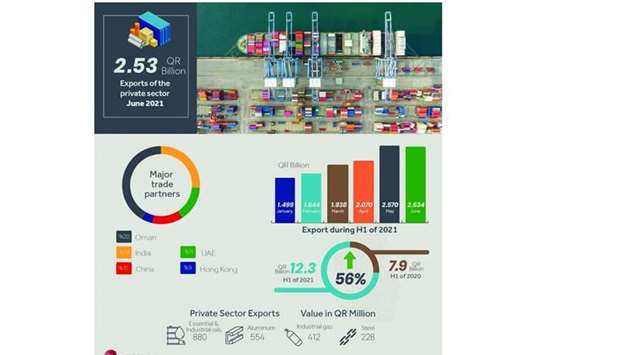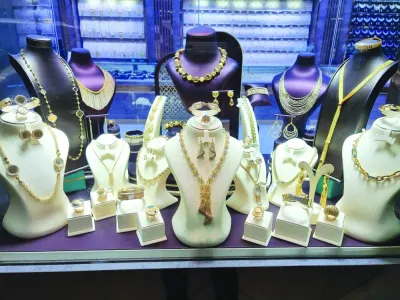The total value of Qatar’s private sector exports stood at QR12.3bn in the first half of 2021, reflecting a 56% growth over QR7.9bn recorded in the same period last year, according to the chamber’s economic newsletter for August.
Data showed that Qatari non-oil exports have recovered from the negative impact of Covid-19 and registered a significant increase both month-on-month (m-o-m) and quarterly to quarterly.
Private sector exports in Q2 2021 amounted to QR7.2bn or a 41% increase over to QR5.1bn in Q1. In the first half of 2021, Oman topped the destinations of Qatari exports, receiving about QR2.58bn.
In June, exports of the private sector amounted to QR2.53bn, showing a 1.4% drop compared to QR2.57bn in May. On the other hand, exports increased by 161% in June 2021 compared to QR973mn in the same period last year. This increase demonstrated that the private sector has reached the recovery phase and its exports have bypassed levels at the beginning of the pandemic.
The increase in private sector exports in June compared to the same month last year is attributed to the increase in exports through all types of certificates except for the Unified Arab Model, which decreased by 26.4%.
Exports through the Unified GCC model recorded a sharp increase of 319.4%, followed by a 185.7% growth under the General Model, and a 9.4% increase through the GSP model certificate.
Month-to-month, private sector exports increased through the Arab Unified Model and Unified GCC Model by 54.71% and 48.55%, respectively, while exports through the General Model, Singapore, and GPS decreased by 19%, 18%, and 12%, respectively.
In June 2021, private sector exports of essential oils dropped 34.2% m-o-m but increased by 1,413% on year-on-year (y-o-y), while steel exports slipped 52.1% m-o-m but jumped 24.2% y-o-y.
Aluminium exports increased 67% m-o-m and 74.2% y-o-y, while industrial gases exports increased 326% m-o-m and 112% y-o-y. Lotrene exports did not register any m-o-m change but increased by 49.8% y-o-y. No chemical fertilisers were exported in May but a 99% decrease was recorded y-o-y.
Petrochemicals increased by 1,050% m-o-m and 134% y-o-y, while paraffin exports decreased by 25.4% m-o-m and 16.7% y-o-y. Chemical substances increased by 190% m-o-m and by 28.8% y-o-y.
Asian countries topped the list of economic blocs that received private sector exports worth QR1.34bn with a share of 53% of the total value, followed by GCC states with a 33% share and exports of QR833.7mn.
The group of EU states recorded exports totalling QR250.3mn representing 10% of the total value, followed by Arab countries (excluding GCC states), which received 66.1mn or a 3% share. The African Countries Group registered exports worth QR21.8mn or a 1% share, while US exports amounted to QR18mn or 1% share. Other European Countries Group received exports of QR1.4mn.
In June 2021, majority of private sector exports went to Oman worth QR517.6mn or a share of 20.4% of the total exports. India received QR487.7mn worth of exports or a share of 19.2% and the UAE with QR285.4mn or 11.3%. China registered QR261.5mn worth of exports or a 10.3% share and Hong Kong with exports worth QR250.7mn or 9.9%. The value of private sector exports to these countries represented 71.1% of the total value of exports during the same month.
Citing figures from the Planning and Statistics Authority for June 2021, the newsletter stated that Qatar’s total value of foreign merchandise trade stood at QR33.7bn, reflecting a 1.5% increase compared to QR33.2bn in May 2021.
In June 2021, the total exports of goods (including exports of goods of domestic origin and re-exports) amounted to QR25.4bn, showing an increase of 1.8% compared to QR24.9bn in May.
Imported goods in the said month amounted to QR8.3bn therefore, the country’s foreign merchandise trade balance, which represents the difference between total exports and imports, showed a surplus of QR17bn or a decrease of 2.7% compared to QR16.6bn in May.
In June 2021, China was leading the countries of destination of Qatar’s foreign trade with QR4.6bn or a share of 13.9% of the state’s total foreign trade.
Ends
Private sector exports in Q2 2021 amounted to QR7.2bn or a 41% increase over to QR5.1bn in Q1. In the first half of 2021, Oman topped the destinations of Qatari exports, receiving about QR2.58bn.
In June, exports of the private sector amounted to QR2.53bn, showing a 1.4% drop compared to QR2.57bn in May. On the other hand, exports increased by 161% in June 2021 compared to QR973mn in the same period last year. This increase demonstrated that the private sector has reached the recovery phase and its exports have bypassed levels at the beginning of the pandemic.
The increase in private sector exports in June compared to the same month last year is attributed to the increase in exports through all types of certificates except for the Unified Arab Model, which decreased by 26.4%.
Exports through the Unified GCC model recorded a sharp increase of 319.4%, followed by a 185.7% growth under the General Model, and a 9.4% increase through the GSP model certificate.
Month-to-month, private sector exports increased through the Arab Unified Model and Unified GCC Model by 54.71% and 48.55%, respectively, while exports through the General Model, Singapore, and GPS decreased by 19%, 18%, and 12%, respectively.
In June 2021, private sector exports of essential oils dropped 34.2% m-o-m but increased by 1,413% on year-on-year (y-o-y), while steel exports slipped 52.1% m-o-m but jumped 24.2% y-o-y.
Aluminium exports increased 67% m-o-m and 74.2% y-o-y, while industrial gases exports increased 326% m-o-m and 112% y-o-y. Lotrene exports did not register any m-o-m change but increased by 49.8% y-o-y. No chemical fertilisers were exported in May but a 99% decrease was recorded y-o-y.
Petrochemicals increased by 1,050% m-o-m and 134% y-o-y, while paraffin exports decreased by 25.4% m-o-m and 16.7% y-o-y. Chemical substances increased by 190% m-o-m and by 28.8% y-o-y.
Asian countries topped the list of economic blocs that received private sector exports worth QR1.34bn with a share of 53% of the total value, followed by GCC states with a 33% share and exports of QR833.7mn.
The group of EU states recorded exports totalling QR250.3mn representing 10% of the total value, followed by Arab countries (excluding GCC states), which received 66.1mn or a 3% share. The African Countries Group registered exports worth QR21.8mn or a 1% share, while US exports amounted to QR18mn or 1% share. Other European Countries Group received exports of QR1.4mn.
In June 2021, majority of private sector exports went to Oman worth QR517.6mn or a share of 20.4% of the total exports. India received QR487.7mn worth of exports or a share of 19.2% and the UAE with QR285.4mn or 11.3%. China registered QR261.5mn worth of exports or a 10.3% share and Hong Kong with exports worth QR250.7mn or 9.9%. The value of private sector exports to these countries represented 71.1% of the total value of exports during the same month.
Citing figures from the Planning and Statistics Authority for June 2021, the newsletter stated that Qatar’s total value of foreign merchandise trade stood at QR33.7bn, reflecting a 1.5% increase compared to QR33.2bn in May 2021.
In June 2021, the total exports of goods (including exports of goods of domestic origin and re-exports) amounted to QR25.4bn, showing an increase of 1.8% compared to QR24.9bn in May.
Imported goods in the said month amounted to QR8.3bn therefore, the country’s foreign merchandise trade balance, which represents the difference between total exports and imports, showed a surplus of QR17bn or a decrease of 2.7% compared to QR16.6bn in May.
In June 2021, China was leading the countries of destination of Qatar’s foreign trade with QR4.6bn or a share of 13.9% of the state’s total foreign trade.
Ends



